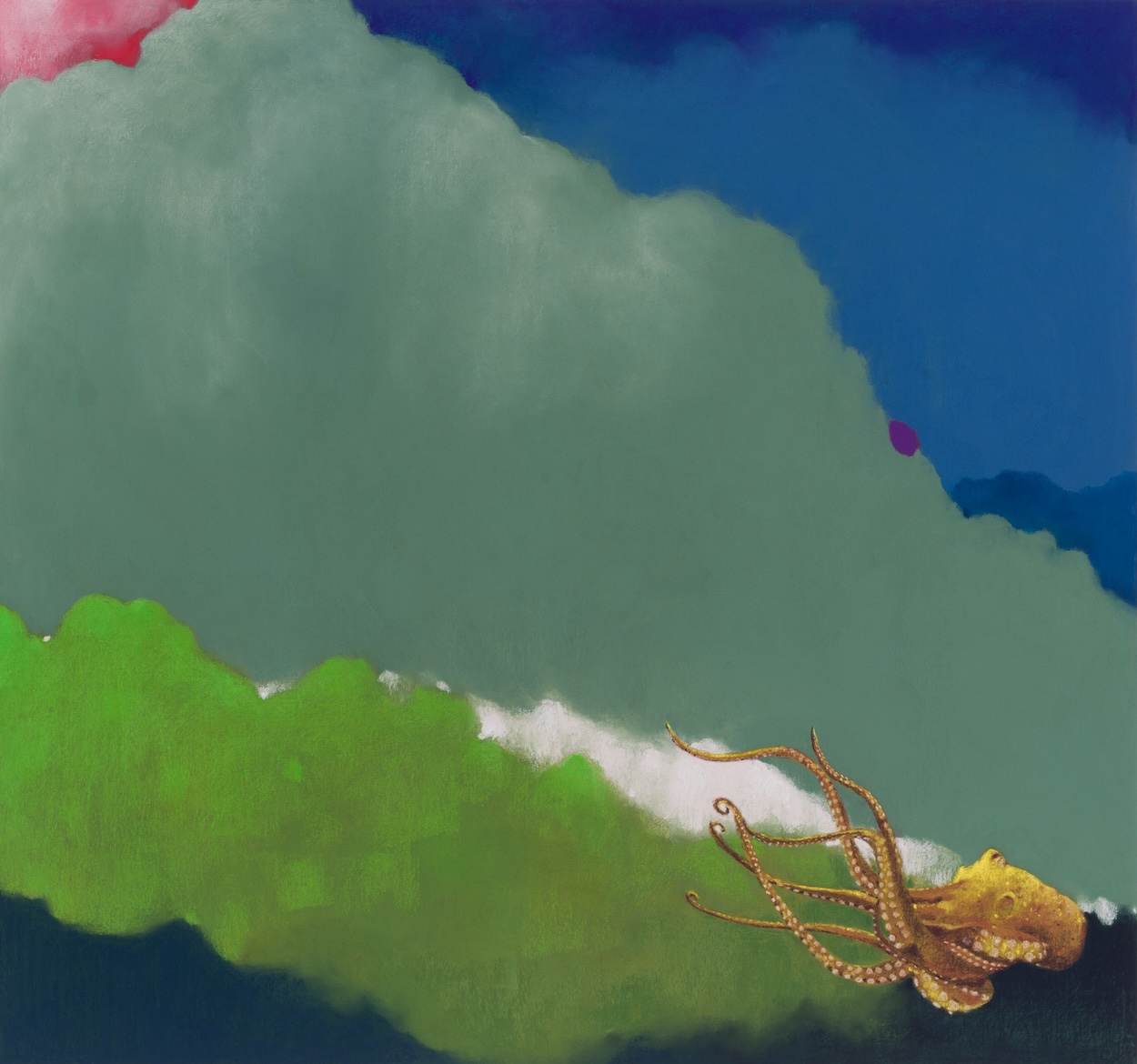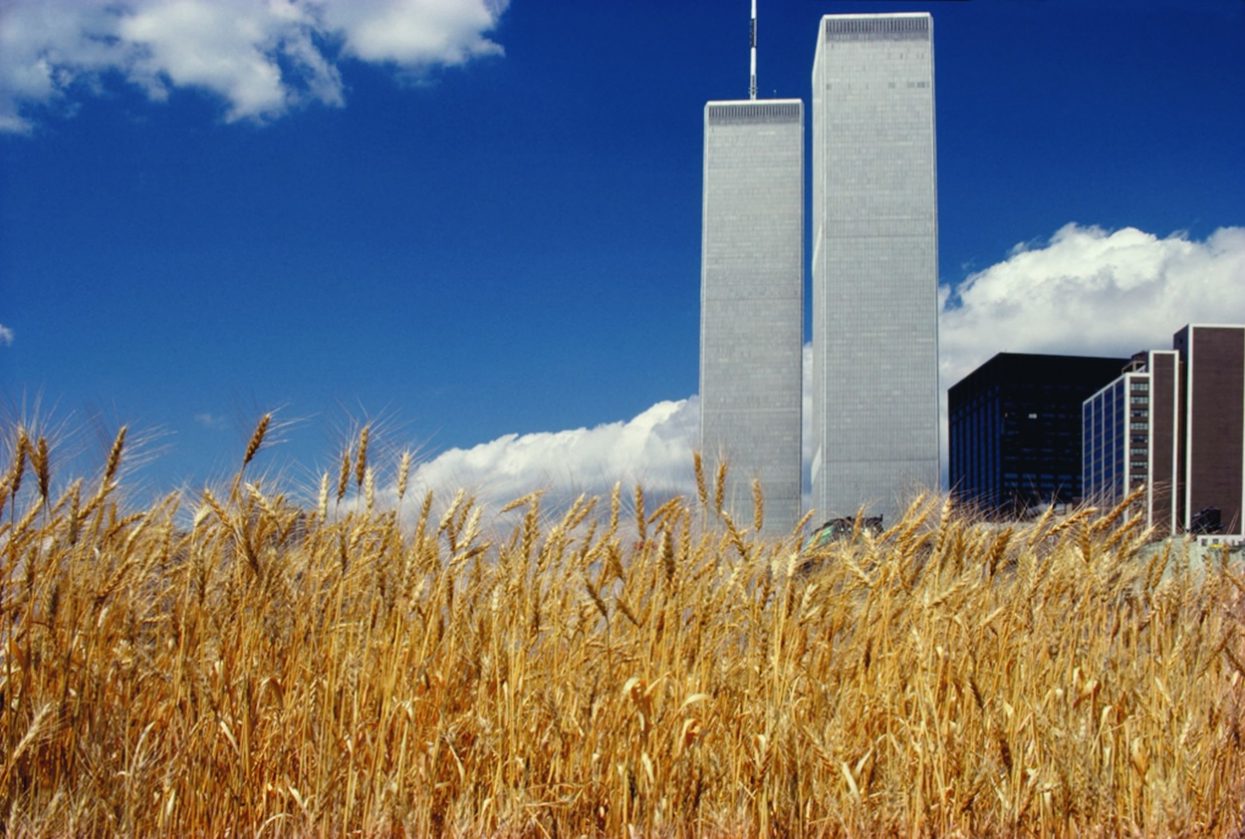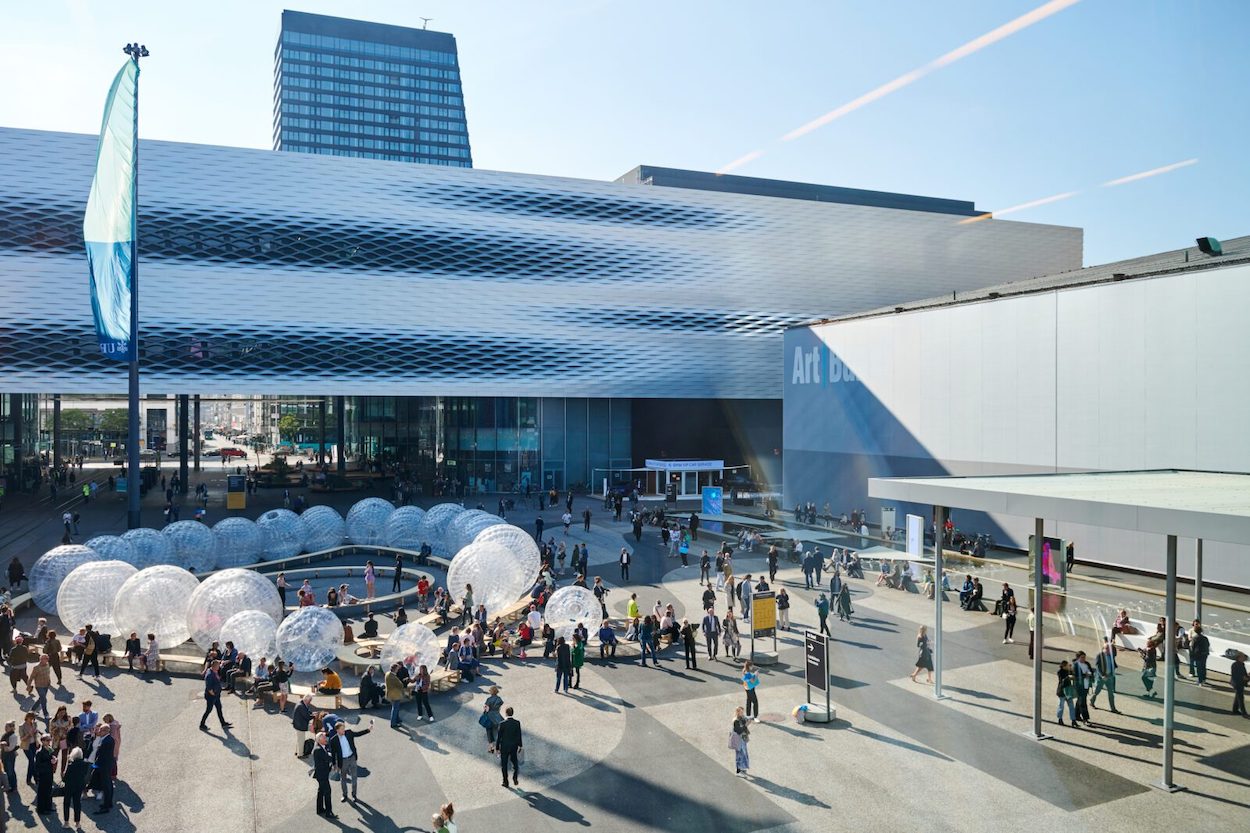The flagship Swiss art fair will bring 285 blue-chip galleries to Messe Basel, but the newly minted fair director is venturing beyond crowded halls and tapping into the city’s creative vitality with nighttime performances, site-specific works sprinkled nearby, and even the ambitious recreation of an Agnes Denes classic.
BY RYAN WADDOUPS June 10, 2024
“When the Sun Goes Away We Paint the Sky” (2024) by Petrit Halilaj at the facade of the former Hotel Merian, Basel. Photography by Peter Macdiarmid for UBS …
Last summer, when Art Basel called Maike Cruse about directing the fair’s flagship edition in Switzerland, she didn’t need to think twice. The veteran director previously served a three-year stint as Art Basel’s communications manager in the early 2010s, but afterward relocated to Berlin where she spent a decade holding positions at the KW Institute of Contemporary Art and the Berlin Biennale before spearheading the success of Gallery Weekend Berlin. Throughout that time, she never missed a single edition of Art Basel, delighting in the annual pilgrimage to the tight-knit Swiss city to immerse herself in one of the most crucial nodes of the blue-chip art market. The fair was growing quickly, launching well-attended editions in Hong Kong and Paris, as well as bolstering online sales thanks to a strong digital program during the pandemic.
During that period of rapid growth, Cruse also noticed how Art Basel was amounting to so much more than the million-dollar sales unfolding at Messe Basel. Thanks to the density of galleries and project spaces popping up in Basel’s walkable central core, the city had been blossoming into a bona fide cultural destination. So for her inaugural edition as director of Art Basel’s high-profile Swiss fair, she decided to tap into the city’s newfound vitality. Beyond the 285 galleries bringing hotly anticipated works to the busy halls of Messe Basel, art commissions will be sprinkled all around the city.
Expect a reconceptualized Parcours sector, which brings site-specific works by the likes of Alvaro Barrington, Mandy El-Sayegh, and Rirkrit Tiravanija to nearby Clarastrasse. The Merian, a newly introduced venue, will stage concerts and performances well into the night. Perhaps the biggest draw is the ambitious recreation of Agnes Denes’ seminal Wheatfield—A Confrontation on Messeplatz. Originally planted and harvested in the shadows of the looming World Trade Center in the early ‘80s, the installation endures as a triumph of Land Art and a reminder of humanity’s role in worsening climate change and ecological calamity.

Maike Cruse. Photography by Debora Mittelstaedt, courtesy of Art Basel …
As Cruse told Surface, perhaps there’s still much to learn from Denes’ gesture. Ahead of the busy fair, Cruse spoke with Surface about her vision for the first Art Basel under her direction—and why it’s so important to venture outside the busy halls.
You’ve worked at Gallery Weekend Berlin, Art Berlin Contemporary, KW Institute of Contemporary Art, and the Berlin Biennale since your last role at Art Basel. What are some of the most important learnings about the contemporary art market and how are you applying them to this year’s edition?
My jobs in Berlin were similar to mine now, but on a different scale. I’m basically a moderator between different stakeholders—galleries, artists, cities, institutions, curators. You work very collaboratively. What’s also very important for both Gallery Weekend Berlin and Art Basel is to always concentrate on the highest quality to make those events successful.
It’s been a decade since you last worked at the fair, but you’ve attended every edition. What are the fair’s—and the city’s—most exciting developments over the past decade?
When I last worked here, we had two fairs and directors. Now, we have two additional fairs on three continents that work with an international team and regional directors spearheading every fair. The team expanded and the fair community grew quite a bit. We also introduced activities like Tokyo Art Week and the UBS Art Basel Art Market Report.
The city’s art scene rejuvenated, too. Basel’s fantastic museums—Kunstmuseum Basel, Fondation Beyeler—all present fantastic shows, especially during Art Basel. Younger galleries are opening around the city, like Galerie Mueller, who’s participating in Art Basel for the first time this year. More global galleries are opening, like Hauser & Wirth, Gagosian, and Contemporary Fine Arts Berlin.

&ldqou;Octopus” (2024) by Nicolas Party. Photography by Adam Reich, courtesy of the artist and Hauser & Wirth …
It seems like Art Basel is making major strides to expand beyond Messe Basel and engage with the city at large. What can we expect from this year’s newly expanded Parcours program and the Merian?
We’re extending our citywide program, starting with a project on Messeplatz—Wheatfield–A Confrontation by pioneering land artist Agnes Denes. We’re showing the new recontextualized Parcours section along Clarastrasse, which connects Messeplatz and the Rhine. It meanders through various venues along the street: a church, shops, a restaurant, a hotel. Stefanie Hessler, the director of the Swiss Institute, curated works by 22 artists discussing topics relevant to cities and their roles as gathering places today. There are new works by Alvaro Barrington and Lap-See Lam; Rirkrit Tiravanija will present flags on the middle bridge on the Rhine and Lois Weinberger will bring a portable garden to Clarastrasse that attracts insects.
Then we have the Merian, where we’ll show performances each night, hosted by different curators like Pati Hapling from Performance Space New York and Aindrea Emelife from Nigeria’s Museum of West African Art. We have a fantastic piece called When the Sun Goes Away, We Paint the Sky by Kosovar artist Petrit Halilaj on the facade of a former hotel. It’s a constellation that shines when the sun goes down.
Why is it so important for Art Basel to engage with the wider public?
One of Art Basel’s biggest strengths is the city. Basel is a small, intimate place, but with such a density of high-profile galleries and artworks in walking distance. This creates a special social energy when everyone’s here. I wanted to enhance this with a program that goes out into the city, but also for people to discover the city and meet, gather, discuss art, and celebrate.
How did the Agnes Denes commission come about?
It was curator Samuel Leuenberger’s idea. It’s such a historical and seminal piece that’s still tackling current discussions, and she’s an overlooked artist. It’s great to bring her back to the center of the art world. Also, Messeplatz is a big concrete square. It’s a perfect comment about what Basel can actually do with it, or what should be done with it, if we should plant forests, lawns, or maybe a wheatfield on concrete. Maybe that’s the future.

“Wheatfield—A Confrontation” (1982) by Agnes Denes at the Battery Park Landfill, Downtown Manhattan. Image courtesy of the artist and Leslie Tonkonow Artworks + Projects …
Art Basel is an ecosystem – Basel is the flagship, and the editions in Miami Beach, Paris, and Hong Kong generally focus on artists from their respective regions. How do you plan to engage with and further differentiate the fair from its other editions, especially Paris?
Each of our cities has a distinct direction and local identity, and we want to work on this more. That’s why each fair currently has local directors. We have a lot in common because Art Basel’s DNA is the same, and we always strive to create the best fairs in their specific region. The main distinction is each fair’s set of galleries. Art Basel in Basel is the most European fair with 60 percent European galleries, but in total they come from 40 countries. Paris has one third French galleries, Miami has mainly American, and Hong Kong has mainly Asian. Each director works closely with our cities and institutions on further fostering the local art community.
At the same time, the directors talk regularly with Vincenzo de Bellis, who oversees all of Art Basel’s fairs and exhibitions. We learn from each other. We start a lot of projects together, like the retail shop we’re launching for the first time this year. We’ll likely bring that to the other fairs.
Art Basel was one of the first fairs to offer virtual viewing rooms during the pandemic. How do digital offerings play into this year’s edition?
Our galleries use online viewing rooms quite a bit, but online sales decreased post-pandemic, as in-person sales rose significantly. People want to see, buy, and talk about art in person. We’re also working with a new digital team headed by Craig Hepburn and working on further offerings with our app, but it’s going to be more in the area of service and communication.
What are you personally most excited about for this year’s edition?
The day before the opening, when all the boxes are opened and the galleries are hanging their works. That’s when you see the show really coming together.
What do you love most about your job?
Art! That’s really what drives me and that’s what I love. I was trained as an artist, and I’ve worked in institutions and ran my own project spaces. I’ve seen the art world and art market from very different perspectives. It’s all about the artists and making their dreams come true.

Messe Basel in 2022. Image courtesy of Art Basel …
Art Basel will take place at Messe Basel (Messeplatz 10) from June 13–16. VIP cardholders can attend the fair as early as June 10.
https://news.google.com/rss/articles/CBMiUGh0dHBzOi8vd3d3LnN1cmZhY2VtYWcuY29tL2FydGljbGVzL2FydC1iYXNlbC1zd2l0emVybGFuZC1tYWlrZS1jcnVzZS1pbnRlcnZpZXcv0gEA?oc=5
2024-06-10 09:03:51Z
Bagikan Berita Ini














0 Response to "Art Basel Director Maike Cruse on What to Expect in Switzerland – SURFACE - Surface Magazine"
Post a Comment